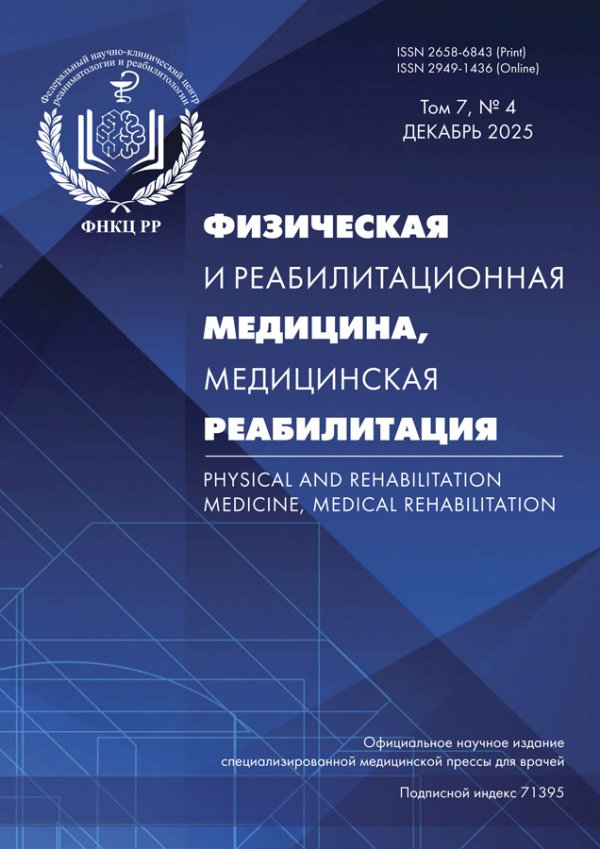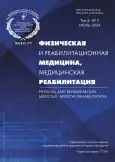Application of virtual reality technologies in the rehabilitation of patients with left and right hemisphere lesions in the acute period of ischemic stroke
- Authors: Tynterova A.M.1
-
Affiliations:
- Immanuel Kant Baltic Federal University
- Issue: Vol 6, No 2 (2024)
- Pages: 109-121
- Section: ORIGINAL STUDY ARTICLE
- URL: https://journals.rcsi.science/2658-6843/article/view/259225
- DOI: https://doi.org/10.36425/rehab627186
- ID: 259225
Cite item
Full Text
Abstract
BACKGROUND: Currently, neurocognitive rehabilitation with the integration of innovative virtual reality (VR) technologies is the standard component of early rehabilitation treatment programs for patients with acute focal brain damage. AIM: Based on the statistical methodology, this study aimed to evaluate the efficiency of neurocognitive rehabilitation with the application VR technologies in patients with left and right hemisphere lesions in the acute period of ischemic stroke. MATERIALS AND METHODS: The study examined 160 patients diagnosed with ischemic stroke exhibiting cognitive impairments. Patients were divided into two groups based on stroke localization: group 1 (n=80) had left hemisphere lesions, whereas group 2 (n=80) had left hemisphere lesions. Since day 5 of hospitalization, in addition to basic therapy, rehabilitation was performed using a hardware–software multimedia complex based on VR for remote-controlled rehabilitation «Devirta-Delphi». Rehabilitation efficiency (RE) was assessed by testing objectively quantitative measures of accuracy and coordination of movement performance before and after treatment using a Kinect Delphi system. Cognitive and psychoemotional measures were assessed by neuropsychological tests on days 2–4 of hospitalization and at the end of the VR therapy. Mathematical statistics were calculated using Python programming language and its libraries Pandas and SciPy. RESULTS: Higher RE values were obtained in patients with right-sided stroke. Irrespective of lesion lateralization, significant improvement was noted with respect to mnestic, executive function, and ideomotor praxis, regression of anxiety, depression, and general aggression. Group 1 also showed an improvement in speech function and a decrease in general asthenia, whereas group 2 showed an increase in attention and emotion recognition ability. Factors that negatively affected RE were identified, namely, apathy, anxiety, prestroke cognitive decline, semantic aphasia, and decreased attention in group 1 and semantic and visual–spatial impairments, prestroke decline, and recurrent stroke in group 2. CONCLUSION: The application of an immersive environment in the early rehabilitation of patients with cognitive impairment improves the performance of verbal and visual tests reflecting mnestic, regulatory, and neurodynamic executive functions in lesions with different lateralization.
Full Text
##article.viewOnOriginalSite##About the authors
A. M. Tynterova
Immanuel Kant Baltic Federal University
Author for correspondence.
Email: antynterova@mail.ru
ORCID iD: 0000-0003-1743-4713
SPIN-code: 2999-5812
MD, Cand. Sci. (Med.), Associate Professor
Russian Federation, 14 Alexander Nevsky street, 236041 KaliningradReferences
- Klochikhina OA, Shprakh VV, Stakhovskaya LV, et al. Dynamics of stroke incidence and mortality indicators over eight-year period in the territories included into the federal program of reorganization of care for patients with stroke. Acta Biomed Sci. 2021;6(1):75–80. EDN: WPNTHD doi: 10.29413/ABS.2021-6.1.10
- Verbitskaya SV, Parfenov VA, Reshetnikov VA, et al. Post-stroke cognitive impairment (results of a 5-year follow-up). Neurol Neuropsychiatry Psychosom. 2018;10(1):37–42. EDN: URIJOY doi: 10.14412/2074-2711-2018-1-37-42
- Einstad MS, Saltvedt I, Lydersen S, et al. Associations between post-stroke motor and cognitive function: A cross-sectional study. BMC Geriatr. 2021;21(1):103. EDN: PYLLQX doi: 10.1186/s12877-021-02055-7
- Karpov OE, Daminov VD, Novak EV, et al. Virtual reality technologies in medical rehabilitation as an example of modern health informatization. Bull Pirogov National Med Surg Center. 2020;15(1): 89–98. EDN: BOJWKM doi: 10.25881/BPNMSC.2020.71.14.017
- Ivanova GЕ, Bodrova RA, Builova TV, et al. Algorithm for formulation a rehabilitation diagnosis using the international classification of functioning in a patient with a stroke: Clinical case. Fizicheskaya i reabilitatsionnaya meditsina, meditsinskaya reabilitatsiya. 2022;4(1):37–54. EDN: FLURCZ doi: 10.36425/rehab96918
- Gerasimova GV, Strukova NV, Kurdybailo SF, et al. Application of smart-approach, evaluation of goals in the patients rehabilitation. Physiсal Rehabilitation Med. 2021;3(4):41–48. EDN: MNQQTZ doi: 10.26211/2658-4522-2021-3-4-41-48
- Kostenko EV, Petrova LV, Pogonchenkova IV, et al. Virtual reality as a technology of multimodal correction of post-stroke motor and cognitive disturbances in conditions of multitasking functioning (literature review). Med J Russian Federation. 2022;28(5):381–394. EDN: KTQSIM doi: 10.17816/medjrf112059
- Gajardo-Vidal A, Lorca-Puls DL, Hope TM, et al. How right hemisphere damage after stroke can impair speech comprehension. Brain. 2018;141(12):3389–3404. doi: 10.1093/brain/awy270
- Lugtmeijer S, Lammers NA, de Haan EH, et al. Post-stroke working memory dysfunction: A meta-analysis and systematic review. Neuropsychol Rev. 2021;31(1):202–219. EDN: AYQEXS doi: 10.1007/s11065-020-09462-4
- Lokshina AB, Grishina DA, Zakharov VV. Vascular cognitive impairment: Issues of diagnosis and treatment. Neurol Neuropsych Psychosomat. 2023;15(2):106–113. EDN: OAXYQT doi: 10.14412/2074-2711-2023-2-106-113
- O’Sullivan MJ, Li X, Galligan D, Pendlebury ST. Cognitive recovery after stroke: Memory. Stroke. 2023;54(1):44–54. EDN: KTIPNE doi: 10.1161/STROKEAHA.122.041497
- Starchina YA. Cognitive disorder after stroke. Medical council. 2017;(1S):27–32. EDN: XUYAUR doi: 10.21518/2079-701X-2017-0-27-32
- Narodova ЕA, Shnayder NA, Narodova VV, et al. The role of brain hemispheric specialization in emotional regulation. Doktor Ru. 2020; 19(4):23–28. EDN: HVEPYX doi: 10.31550/1727-2378-2020-19-4-23-28
- O’Connell K, Marsh AA, Edwards DF, et al. Emotion recognition impairments and social well-being following right-hemisphere stroke. Neuropsychol Rehab. 2022; 32(7):1337–1355. doi: 10.1080/09602011.2021.1888756
- Cai W, Mueller C, Li YJ, et al. Post stroke depression and risk of stroke recurrence and mortality: A systematic review and meta-analysis. Ageing Res Rev. 2019; 50:102–109. doi: 10.1016/j.arr.2019.01.013
- Tay J, Morris RG, Markus HS. Apathy after stroke: Diagnosis, mechanisms, consequences, and treatment. Int J Stroke. 2021; 16(5):510–518. doi: 10.1177/1747493021990906
- Liu Y, Tan W, Chen C, et al. A review of the application of virtual reality technology in the diagnosis and treatment of cognitive impairment. Front Aging Neurosci. 2019;(11):280. doi: 10.3389/fnagi.2019.00280
- Park W, Kim J, Kim M. Efficacy of virtual reality therapy in ideomotor apraxia rehabilitation: A case report. Medicine (Baltimore). 2021;100(28):e26657. doi: 10.1097/MD.0000000000026657
- Demeco A, Zola L, Frizziero A, et al. Immersive virtual reality in post-stroke rehabilitation: A systematic review. Sensors (Basel). 2023;23(3):1712. EDN: JUYXAW doi: 10.3390/s23031712
- Giachero A, Calati M, Pia L, et al. Conversational therapy through semi-immersive virtual reality environments for language recovery and psychological well-being in post stroke aphasia. Behav Neurol. 2020;2020:2846046. EDN: BYVAHO doi: 10.1155/2020/2846046
- Patsaki I, Dimitriadi N, Despoti A, et al. The effectiveness of immersive virtual reality in physical recovery of stroke patients: A systematic review. Front Syst Neurosci. 2022;(16):880447. EDN: JMRIFL doi: 10.3389/fnsys.2022.880447
- Marín-Morales J, Llinares C, Guixeres J, et al. Emotion recognition in immersive virtual reality: From statistics to affective computing. Sensors (Basel). 2020;20(18):5163. EDN: AMMKCA doi: 10.3390/s20185163
- Li W, Xiao WM, Chen YK, et al. Anxiety in patients with acute ischemic stroke: Risk factors and effects on functional status. Front Psychiatry. 2019;(10):257. doi: 10.3389/fpsyt.2019.00257
- Zhang T, Liu W, Bai Q, et al. Virtual reality technology in the rehabilitation of post-stroke cognitive impairment: An opinion article on recent findings. Front Psychol. 2023;(14):1271458. EDN: VZXBOY doi: 10.3389/fpsyg.2023.1271458
- Cherdak MA. Mixed dementia in stroke patient. Russ J Geriatric Med. 2020;(3):236–242. EDN: NTHOUX doi: 10.37586/2686-8636-3-2020-236-242
- Pinho J, Quintas-Neves M, Dogan I, et al. Incident stroke in patients with Alzheimer’s disease: Systematic review and meta-analysis. Sci Rep. 2021;11(1):16385. doi: 10.1038/s41598-021-95821-x
- Parfenov VA. Vascular cognitive impairment and chronic cerebral ischemia (dyscirculatory encephalopathy). Neurol Neuropsychi Psychosomat. 2019; 11(3S):61–67. EDN: KWRPMJ doi: 10.14412/2074-2711-2019-3S-61-67
- Donnelly MR, Reinberg R, Ito KL, et al. Virtual reality for the treatment of anxiety disorders: A scoping review. Am J Occup Ther. 2021; 75(6):7506205040. doi: 10.5014/ajot.2021.046169
- De Luca R, Torrisi M, Piccolo A, et al. Improving post-stroke cognitive and behavioral abnormalities by using virtual reality: A case report on a novel use of nirvana. Appl Neuropsychol Adult. 2018; 25(6):581–585. doi: 10.1080/23279095.2017.1338571
Supplementary files










